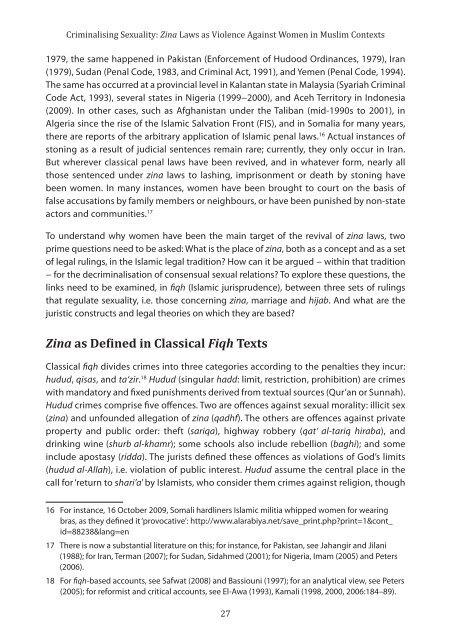control and sexuality
control and sexuality
control and sexuality
- No tags were found...
You also want an ePaper? Increase the reach of your titles
YUMPU automatically turns print PDFs into web optimized ePapers that Google loves.
Criminalising Sexuality: Zina Laws as Violence Against Women in Muslim Contexts1979, the same happened in Pakistan (Enforcement of Hudood Ordinances, 1979), Iran(1979), Sudan (Penal Code, 1983, <strong>and</strong> Criminal Act, 1991), <strong>and</strong> Yemen (Penal Code, 1994).The same has occurred at a provincial level in Kalantan state in Malaysia (Syariah CriminalCode Act, 1993), several states in Nigeria (1999−2000), <strong>and</strong> Aceh Territory in Indonesia(2009). In other cases, such as Afghanistan under the Taliban (mid-1990s to 2001), inAlgeria since the rise of the Islamic Salvation Front (FIS), <strong>and</strong> in Somalia for many years,there are reports of the arbitrary application of Islamic penal laws. 16 Actual instances ofstoning as a result of judicial sentences remain rare; currently, they only occur in Iran.But wherever classical penal laws have been revived, <strong>and</strong> in whatever form, nearly allthose sentenced under zina laws to lashing, imprisonment or death by stoning havebeen women. In many instances, women have been brought to court on the basis offalse accusations by family members or neighbours, or have been punished by non-stateactors <strong>and</strong> communities. 17To underst<strong>and</strong> why women have been the main target of the revival of zina laws, twoprime questions need to be asked: What is the place of zina, both as a concept <strong>and</strong> as a setof legal rulings, in the Islamic legal tradition? How can it be argued − within that tradition− for the decriminalisation of consensual sexual relations? To explore these questions, thelinks need to be examined, in fiqh (Islamic jurisprudence), between three sets of rulingsthat regulate <strong>sexuality</strong>, i.e. those concerning zina, marriage <strong>and</strong> hijab. And what are thejuristic constructs <strong>and</strong> legal theories on which they are based?Zina as Defined in Classical Fiqh TextsClassical fiqh divides crimes into three categories according to the penalties they incur:hudud, qisas, <strong>and</strong> ta‘zir. 18 Hudud (singular hadd: limit, restriction, prohibition) are crimeswith m<strong>and</strong>atory <strong>and</strong> fixed punishments derived from textual sources (Qur’an or Sunnah).Hudud crimes comprise five offences. Two are offences against sexual morality: illicit sex(zina) <strong>and</strong> unfounded allegation of zina (qadhf). The others are offences against privateproperty <strong>and</strong> public order: theft (sariqa), highway robbery (qat‘ al-tariq hiraba), <strong>and</strong>drinking wine (shurb al-khamr); some schools also include rebellion (baghi); <strong>and</strong> someinclude apostasy (ridda). The jurists defined these offences as violations of God’s limits(hudud al-Allah), i.e. violation of public interest. Hudud assume the central place in thecall for ‘return to shari’a’ by Islamists, who consider them crimes against religion, though16 For instance, 16 October 2009, Somali hardliners Islamic militia whipped women for wearingbras, as they defined it ‘provocative’: http://www.alarabiya.net/save_print.php?print=1&cont_id=88238&lang=en17 There is now a substantial literature on this; for instance, for Pakistan, see Jahangir <strong>and</strong> Jilani(1988); for Iran, Terman (2007); for Sudan, Sidahmed (2001); for Nigeria, Imam (2005) <strong>and</strong> Peters(2006).18 For fiqh-based accounts, see Safwat (2008) <strong>and</strong> Bassiouni (1997); for an analytical view, see Peters(2005); for reformist <strong>and</strong> critical accounts, see El-Awa (1993), Kamali (1998, 2000, 2006:184–89).27


